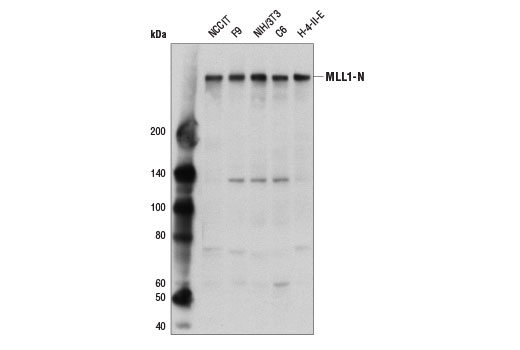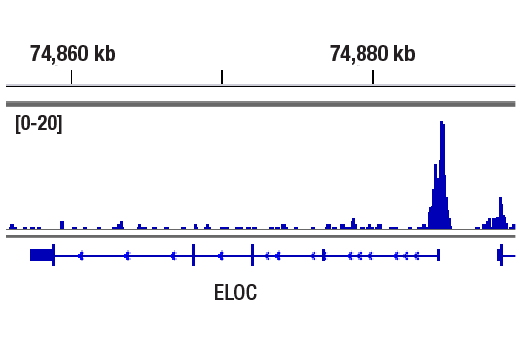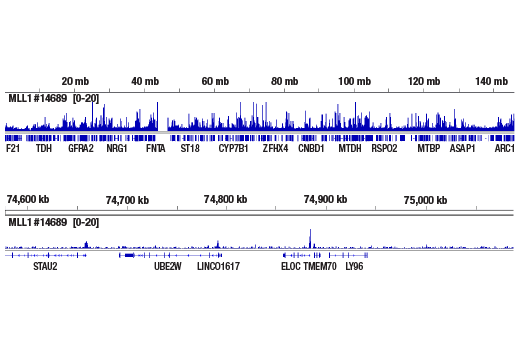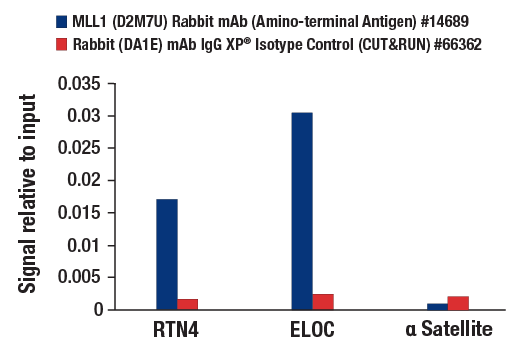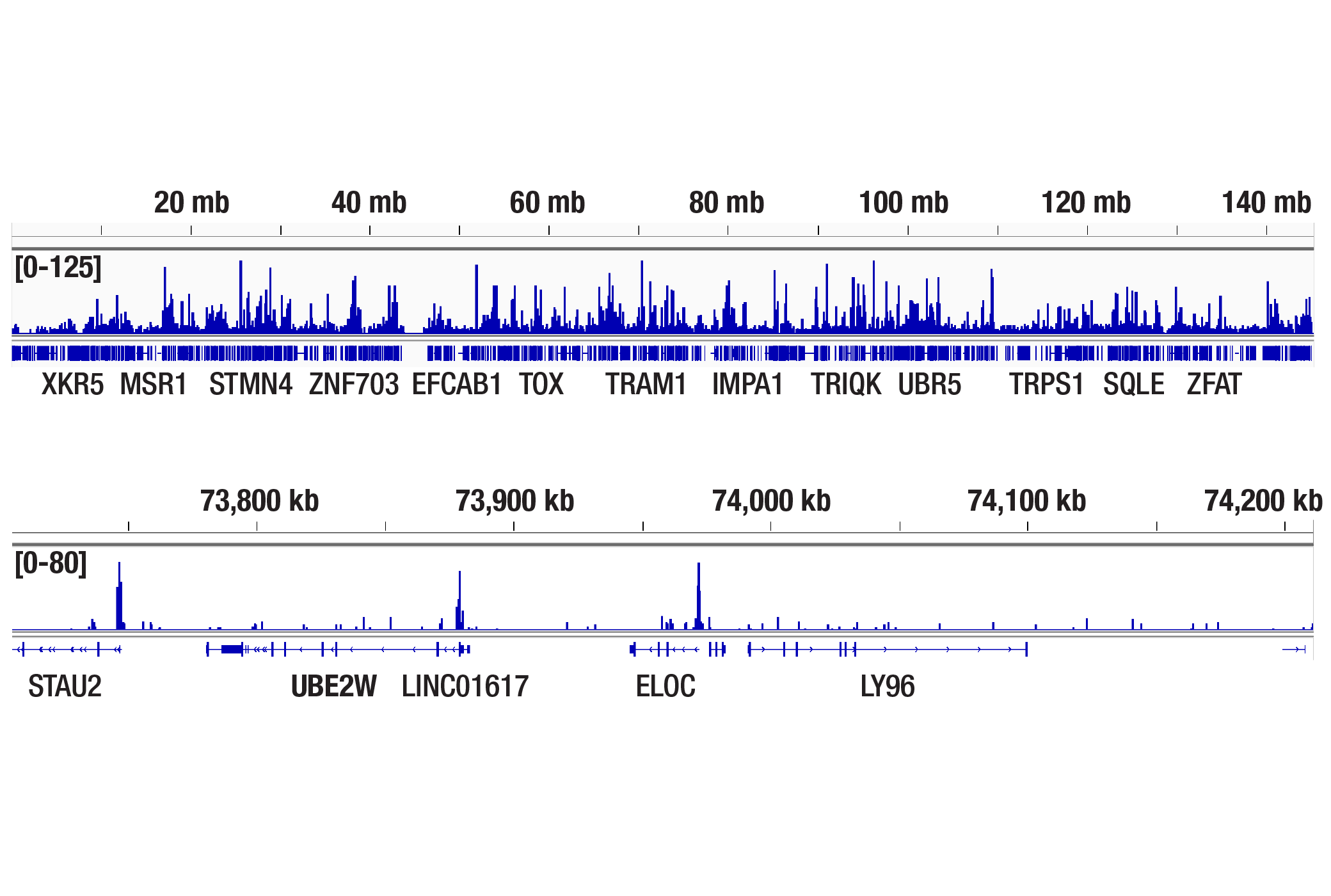WB, IP, C&R, C&T
H M R Mk
Endogenous
300
Rabbit IgG
#Q03164
4297
Product Information
Product Usage Information
Storage
Specificity / Sensitivity
Species Reactivity:
Human, Mouse, Rat, Monkey
Source / Purification
Monoclonal antibody is produced by immunizing animals with recombinant protein specific to the amino terminus of human MLL1 protein.
Background
The Set1 histone methyltransferase protein was first identified in yeast as part of the Set1/COMPASS histone methyltransferase complex, which methylates histone H3 at Lys4 and functions as a transcriptional co-activator (1). While yeast contain only one known Set1 protein, mammals contain six Set1-related proteins: SET1A, SET1B, MLL1, MLL2, MLL3, and MLL4, all of which assemble into COMPASS-like complexes and methylate histone H3 at Lys4 (2,3). These Set1-related proteins are each found in distinct protein complexes, all of which share the common subunits WDR5, RBBP5, ASH2L, CXXC1, and DPY30, which are required for proper complex assembly and modulation of histone methyltransferase activity (2-6). MLL1 and MLL2 complexes contain the additional protein subunit, menin (6).
MLL1 functions as a master regulator of both embryogenesis and hematopoiesis, and is required for proper expression of Hox genes (7,8). MLL1 is a large, approximately 4000 amino acid, protein that is cleaved by the taspase 1 threonine endopeptidase to form N-terminal (MLL1-N) and C-terminal MLL1 (MLL1-C) fragments, both of which are subunits of the functional MLL1/COMPASS complex (9,10). MLL1-N, MLL1-C, WDR5, RBBP5, and ASH2L define the core catalytic component of the MLL1/COMPASS complex, which is recruited to target genes and methylates histone H3 lysine 4 to regulate transcriptional initiation (11). At least 60 different MLL1 translocation partners have been molecularly characterized and associated with various hematological malignancies. The most common translocation partners include AF4, AF9, ENL, AF10, ELL, and AF6 (8,12,13). With the exception of AF6, all of these partners are nuclear proteins that function to positively regulate transcriptional elongation. AF4, AF9, and ENL are all components of the super elongation complex (SEC), while AF4, AF9, AF10, and ENL all interact with the histone H3 lysine 79 methyltransferase DOT1L. Many MLL1 target genes are normally regulated by promoter-proximal pausing, with the release of RNA polymerase and transcriptional elongation occurring in response to proper stimuli (14). The association of MLL1 translocation partners with SEC and DOT1L suggest that MLL1-fusion proteins may function to sustain specific gene expression programs by constitutively activating transcriptional elongation.
- Miller, T. et al. (2001) Proc Natl Acad Sci U S A 98, 12902-7.
- Shilatifard, A. (2008) Curr Opin Cell Biol 20, 341-8.
- Tenney, K. and Shilatifard, A. (2005) J Cell Biochem 95, 429-36.
- Lee, J.H. and Skalnik, D.G. (2005) J Biol Chem 280, 41725-31.
- Lee, J.H. et al. (2007) J Biol Chem 282, 13419-28.
- Hughes, C.M. et al. (2004) Mol Cell 13, 587-97.
- Eissenberg, J.C. and Shilatifard, A. (2010) Dev Biol 339, 240-9.
- Smith, E. et al. (2011) Genes Dev 25, 661-72.
- Takeda, S. et al. (2006) Genes Dev 20, 2397-409.
- Yokoyama, A. et al. (2002) Blood 100, 3710-8.
- Dou, Y. et al. (2006) Nat Struct Mol Biol 13, 713-9.
- Yip, B.H. and So, C.W. (2013) Exp Biol Med (Maywood) 238, 315-23.
- Neff, T. and Armstrong, S.A. (2013) Blood 121, 4847-53.
- Wang, P. et al. (2009) Mol Cell Biol 29, 6074-85.
Species Reactivity
Species reactivity is determined by testing in at least one approved application (e.g., western blot).
Western Blot Buffer
IMPORTANT: For western blots, incubate membrane with diluted primary antibody in 5% w/v BSA, 1X TBS, 0.1% Tween® 20 at 4°C with gentle shaking, overnight.
Applications Key
WB: Western Blotting IP: Immunoprecipitation C&R: CUT&RUN C&T: CUT&Tag
Cross-Reactivity Key
H: human M: mouse R: rat Hm: hamster Mk: monkey Vir: virus Mi: mink C: chicken Dm: D. melanogaster X: Xenopus Z: zebrafish B: bovine Dg: dog Pg: pig Sc: S. cerevisiae Ce: C. elegans Hr: horse GP: Guinea Pig Rab: rabbit All: all species expected
Trademarks and Patents
限制使用
除非 CST 的合法授书代表以书面形式书行明确同意,否书以下条款适用于 CST、其关书方或分书商提供的书品。 任何书充本条款或与本条款不同的客书条款和条件,除非书 CST 的合法授书代表以书面形式书独接受, 否书均被拒书,并且无效。
专品专有“专供研究使用”的专专或专似的专专声明, 且未专得美国食品和专品管理局或其他外国或国内专管机专专专任何用途的批准、准专或专可。客专不得将任何专品用于任何专断或治专目的, 或以任何不符合专专声明的方式使用专品。CST 专售或专可的专品提供专作专最专用专的客专,且专用于研专用途。将专品用于专断、专防或治专目的, 或专专售(专独或作专专成)或其他商专目的而专专专品,均需要 CST 的专独专可。客专:(a) 不得专独或与其他材料专合向任何第三方出售、专可、 出借、捐专或以其他方式专专或提供任何专品,或使用专品制造任何商专专品,(b) 不得复制、修改、逆向工程、反专专、 反专专专品或以其他方式专专专专专品的基专专专或技专,或使用专品开专任何与 CST 的专品或服专专争的专品或服专, (c) 不得更改或专除专品上的任何商专、商品名称、徽专、专利或版专声明或专专,(d) 只能根据 CST 的专品专售条款和任何适用文档使用专品, (e) 专遵守客专与专品一起使用的任何第三方专品或服专的任何专可、服专条款或专似专专
